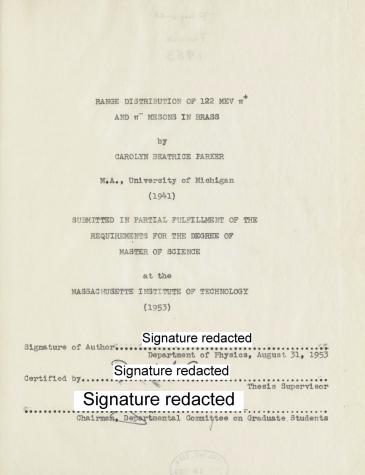Publications
Abstract
Ilford 0-3 stripped emulsions embedded in brass absorbers were exposed to the 122 Mev [\pi^+] and [\pi^-] meson beams of the University of Chicago synchro-cyclotron by Dr. X.B. Scott, formerly of this laboratory, in December 1951. The plates were oriented parallel to the beam.
The purpose of this report is to present an analysis of the range distribution of 122 Mev [\pi^+] and [\pi^-] mesons in brass as recorded by the nuclear plates. It is also desired to get some information on the total cross section for nuclear interaction.
One plate exposed in separate runs to [\pi^+] and [\pi^-] beams was scanned. Negative pions were distinguished by the fact that when they come to rest in an emulsion they generally produce nuclear stars. Positive pions were identified by the fact that when they come to rest in the emulsion they decay into [\mu] mesons.
The distribution of [\pi^+] meson ranges in brass when subjected to statistical tests yielded a Gaussian distribution with a mean of 66.8 [\pm] .014 mm. and a standard deviation of 5.0 [\pm] .005 mm. Similarly the [\pi^-] distribution was found to have a mean of 66.8.[\pm] .007 mm. and a standard deviation of 5.5 [\pm] .005 mm. These results give a range in brass of 56.7 gm/[cm^2] for 122 Mev pions which is in agreement with Aron's calculated value.
Total cross section calculations indicate cross sections for [\pi^+] and [\pi^-] mesons at 122 Mev are not noticeably different.
Bio
Carolyn Beatrice Parker MS '51 earned an MS in mathematics from University of Michigan (1941) and an MS in physics from MIT (1951). Despite finishing coursework for her PhD in physics at MIT, illness prevented Parker from completing her doctoral program. At age 48, she died from leukemia, likely a result of her research work with the Dayton Project during World War II. Parker is considered the first African-American to earn a postgraduate degree in physics, and the first African-American to earn a postgraduate degree in physics from MIT.
Parker, Caroline Beatrice. Range distribution of 122 Mev (pi⁺) and (pi⁻) mesons in brass. Thesis (M.S.) Massachusetts Institute of Technology. Dept. of Physics, 1953.
